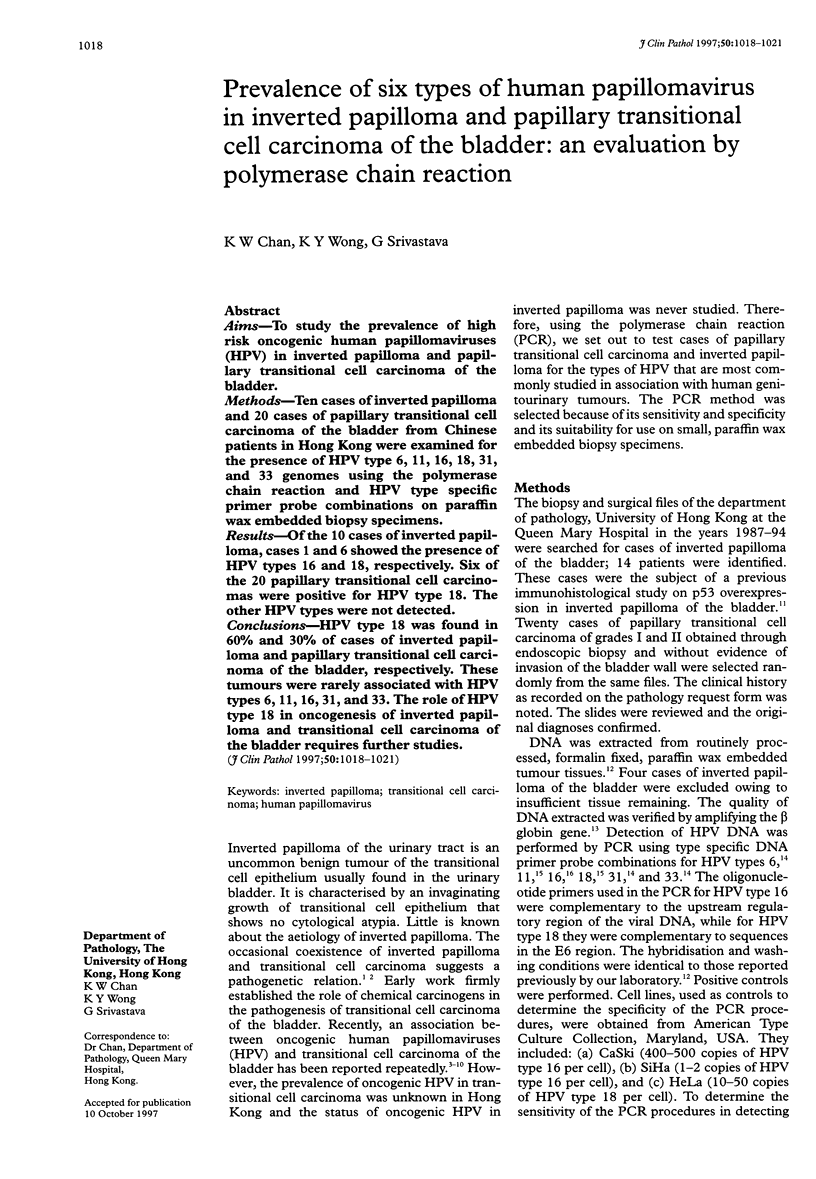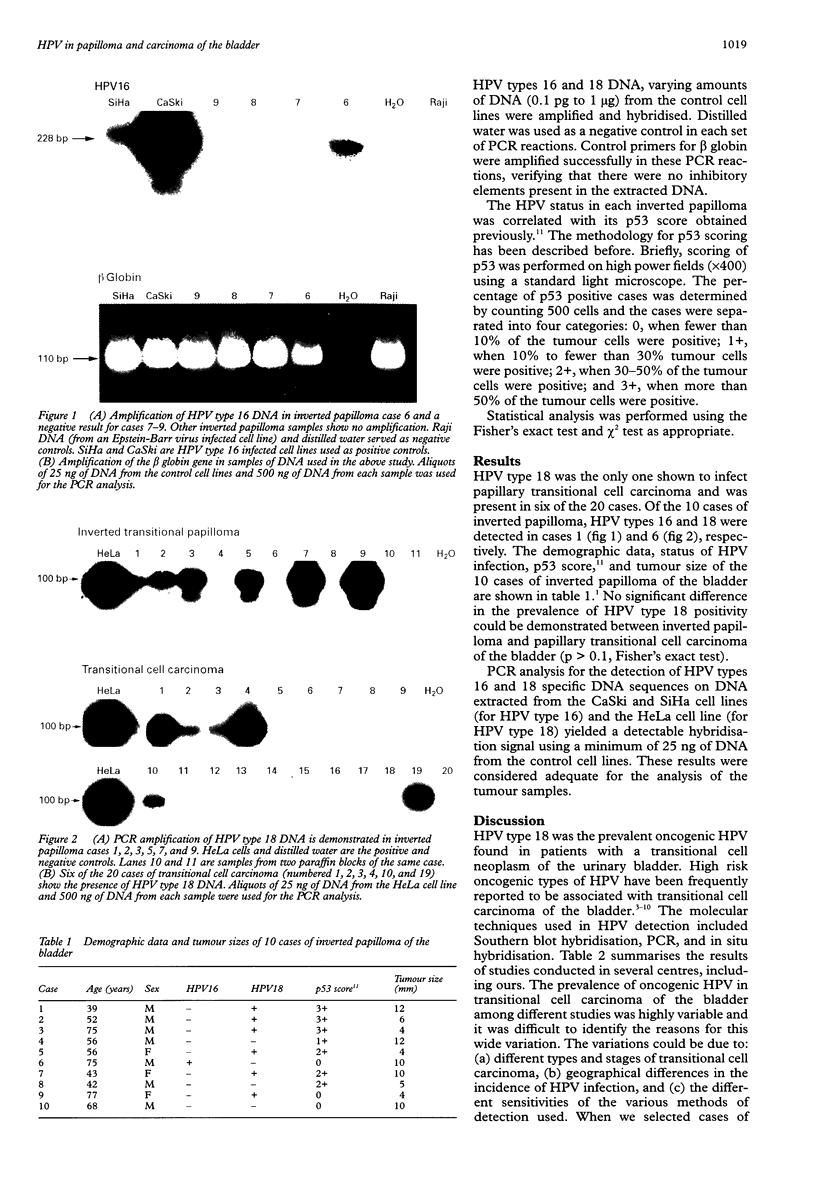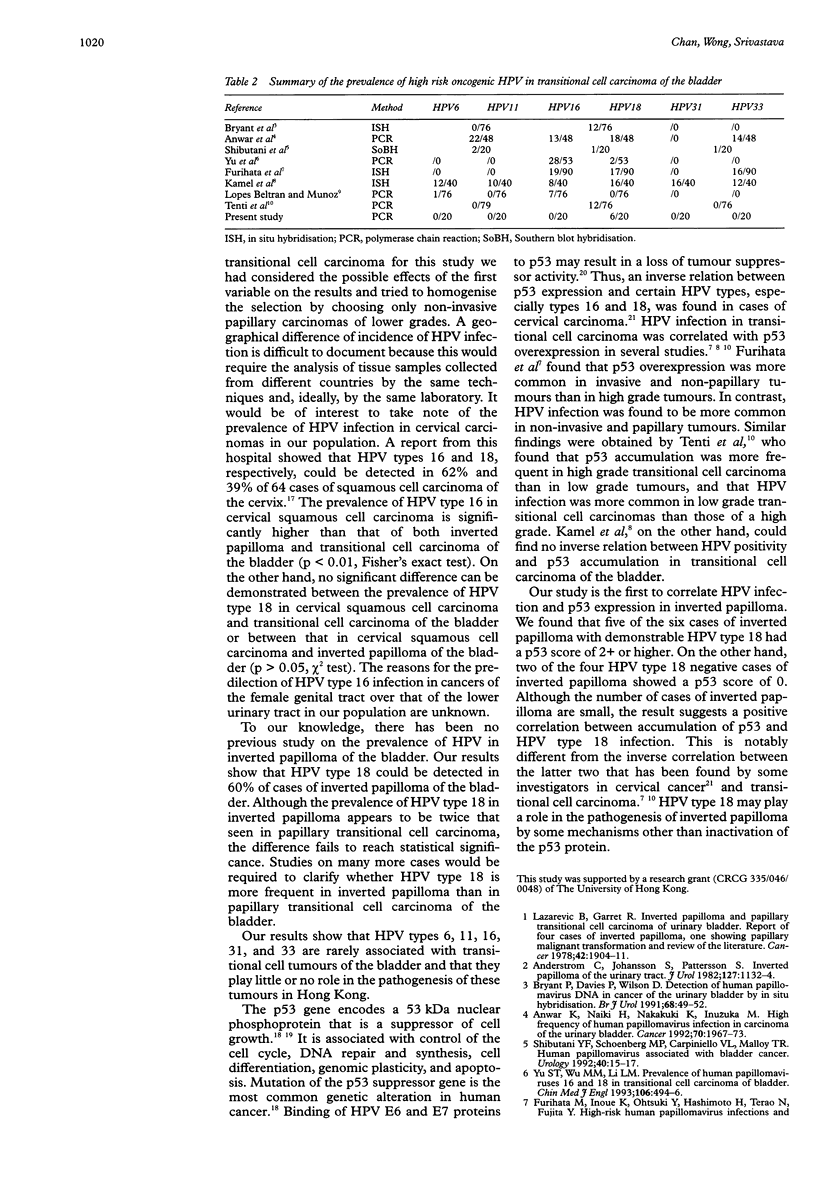Abstract
AIMS: To study the prevalence of high risk oncogenic human papillomaviruses (HPV) in inverted papilloma and papillary transitional cell carcinoma of the bladder. METHODS: Ten cases of inverted papilloma and 20 cases of papillary transitional cell carcinoma of the bladder from Chinese patients in Hong Kong were examined for the presence of HPV type 6, 11, 16, 18, 31, and 33 genomes using the polymerase chain reaction and HPV type specific primer probe combinations on paraffin wax embedded biopsy specimens. RESULTS: Of the 10 cases of inverted papilloma, cases 1 and 6 showed the presence of HPV types 16 and 18, respectively. Six of the 20 papillary transitional cell carcinomas were positive for HPV type 18. The other HPV types were not detected. CONCLUSIONS: HPV type 18 was found in 60% and 30% of cases of inverted papilloma and papillary transitional cell carcinoma of the bladder, respectively. These tumours were rarely associated with HPV types 6, 11, 16, 31, and 33. The role of HPV type 18 in oncogenesis of inverted papilloma and transitional cell carcinoma of the bladder requires further studies.
Full text
PDF



Images in this article
Selected References
These references are in PubMed. This may not be the complete list of references from this article.
- Anwar K., Naiki H., Nakakuki K., Inuzuka M. High frequency of human papillomavirus infection in carcinoma of the urinary bladder. Cancer. 1992 Oct 1;70(7):1967–1973. doi: 10.1002/1097-0142(19921001)70:7<1967::aid-cncr2820700726>3.0.co;2-8. [DOI] [PubMed] [Google Scholar]
- Bryant P., Davies P., Wilson D. Detection of human papillomavirus DNA in cancer of the urinary bladder by in situ hybridisation. Br J Urol. 1991 Jul;68(1):49–52. doi: 10.1111/j.1464-410x.1991.tb15256.x. [DOI] [PubMed] [Google Scholar]
- Chan K. W., Lam K. Y., Chan A. C., Lau P., Srivastava G. Prevalence of human papillomavirus types 16 and 18 in penile carcinoma: a study of 41 cases using PCR. J Clin Pathol. 1994 Sep;47(9):823–826. doi: 10.1136/jcp.47.9.823. [DOI] [PMC free article] [PubMed] [Google Scholar]
- Furihata M., Inoue K., Ohtsuki Y., Hashimoto H., Terao N., Fujita Y. High-risk human papillomavirus infections and overexpression of p53 protein as prognostic indicators in transitional cell carcinoma of the urinary bladder. Cancer Res. 1993 Oct 15;53(20):4823–4827. [PubMed] [Google Scholar]
- Hollstein M., Sidransky D., Vogelstein B., Harris C. C. p53 mutations in human cancers. Science. 1991 Jul 5;253(5015):49–53. doi: 10.1126/science.1905840. [DOI] [PubMed] [Google Scholar]
- Kamel D., Päkkö P., Pöllänen R., Vähäkangas K., Lehto V. P., Soini Y. Human papillomavirus DNA and abnormal p53 expression in carcinoma of the urinary bladder. APMIS. 1995 May;103(5):331–338. doi: 10.1111/j.1699-0463.1995.tb01116.x. [DOI] [PubMed] [Google Scholar]
- Lazarevic B., Garret R. Inverted papilloma and papillary transitional cell carcinoma of urinary bladder: report of four cases of inverted papilloma, one showing papillary malignant transformation and review of the literature. Cancer. 1978 Oct;42(4):1904–1911. doi: 10.1002/1097-0142(197810)42:4<1904::aid-cncr2820420431>3.0.co;2-3. [DOI] [PubMed] [Google Scholar]
- Lopez-Beltran A., Muñoz E. Transitional cell carcinoma of the bladder: low incidence of human papillomavirus DNA detected by the polymerase chain reaction and in situ hybridization. Histopathology. 1995 Jun;26(6):565–569. doi: 10.1111/j.1365-2559.1995.tb00276.x. [DOI] [PubMed] [Google Scholar]
- Lorincz A. T., Temple G. F., Kurman R. J., Jenson A. B., Lancaster W. D. Oncogenic association of specific human papillomavirus types with cervical neoplasia. J Natl Cancer Inst. 1987 Oct;79(4):671–677. [PubMed] [Google Scholar]
- Ngan H. Y., Stanley M., Liu S. S., Ma H. K. HPV and p53 in cervical cancer. Genitourin Med. 1994 Jun;70(3):167–170. doi: 10.1136/sti.70.3.167. [DOI] [PMC free article] [PubMed] [Google Scholar]
- Saiki R. K., Scharf S., Faloona F., Mullis K. B., Horn G. T., Erlich H. A., Arnheim N. Enzymatic amplification of beta-globin genomic sequences and restriction site analysis for diagnosis of sickle cell anemia. Science. 1985 Dec 20;230(4732):1350–1354. doi: 10.1126/science.2999980. [DOI] [PubMed] [Google Scholar]
- Scheffner M., Werness B. A., Huibregtse J. M., Levine A. J., Howley P. M. The E6 oncoprotein encoded by human papillomavirus types 16 and 18 promotes the degradation of p53. Cell. 1990 Dec 21;63(6):1129–1136. doi: 10.1016/0092-8674(90)90409-8. [DOI] [PubMed] [Google Scholar]
- Shibutani Y. F., Schoenberg M. P., Carpiniello V. L., Malloy T. R. Human papillomavirus associated with bladder cancer. Urology. 1992 Jul;40(1):15–17. doi: 10.1016/0090-4295(92)90429-z. [DOI] [PubMed] [Google Scholar]
- Tenti P., Zappatore R., Romagnoli S., Civardi E., Giunta P., Scelsi R., Stella G., Carnevali L. p53 overexpression and human papillomavirus infection in transitional cell carcinoma of the urinary bladder: correlation with histological parameters. J Pathol. 1996 Jan;178(1):65–70. doi: 10.1002/(SICI)1096-9896(199601)178:1<65::AID-PATH451>3.0.CO;2-W. [DOI] [PubMed] [Google Scholar]
- Tidy J. A., Vousden K. H., Farrell P. J. Relation between infection with a subtype of HPV16 and cervical neoplasia. Lancet. 1989 Jun 3;1(8649):1225–1227. doi: 10.1016/s0140-6736(89)92329-5. [DOI] [PubMed] [Google Scholar]
- Van Den Brule A. J., Walboomers J. M., Du Maine M., Kenemans P., Meijer C. J. Difference in prevalence of human papillomavirus genotypes in cytomorphologically normal cervical smears is associated with a history of cervical intraepithelial neoplasia. Int J Cancer. 1991 May 30;48(3):404–408. doi: 10.1002/ijc.2910480317. [DOI] [PubMed] [Google Scholar]
- Vogelstein B., Kinzler K. W. p53 function and dysfunction. Cell. 1992 Aug 21;70(4):523–526. doi: 10.1016/0092-8674(92)90421-8. [DOI] [PubMed] [Google Scholar]
- Young L. S., Bevan I. S., Johnson M. A., Blomfield P. I., Bromidge T., Maitland N. J., Woodman C. B. The polymerase chain reaction: a new epidemiological tool for investigating cervical human papillomavirus infection. BMJ. 1989 Jan 7;298(6665):14–18. doi: 10.1136/bmj.298.6665.14. [DOI] [PMC free article] [PubMed] [Google Scholar]
- Yu S. T., Wu M. M., Li L. M. Prevalence of human papillomaviruses 16 and 18 in transitional cell carcinoma of bladder. Chin Med J (Engl) 1993 Jul;106(7):494–496. [PubMed] [Google Scholar]




